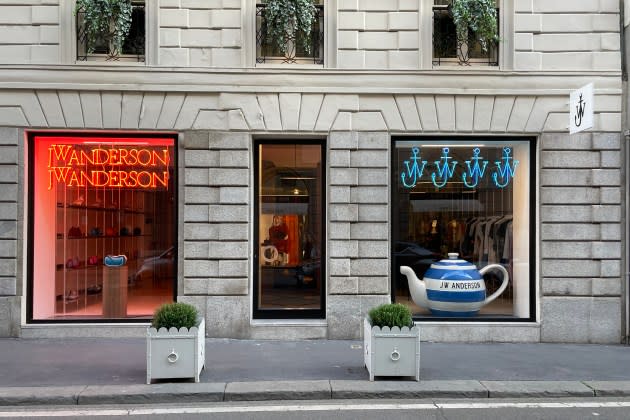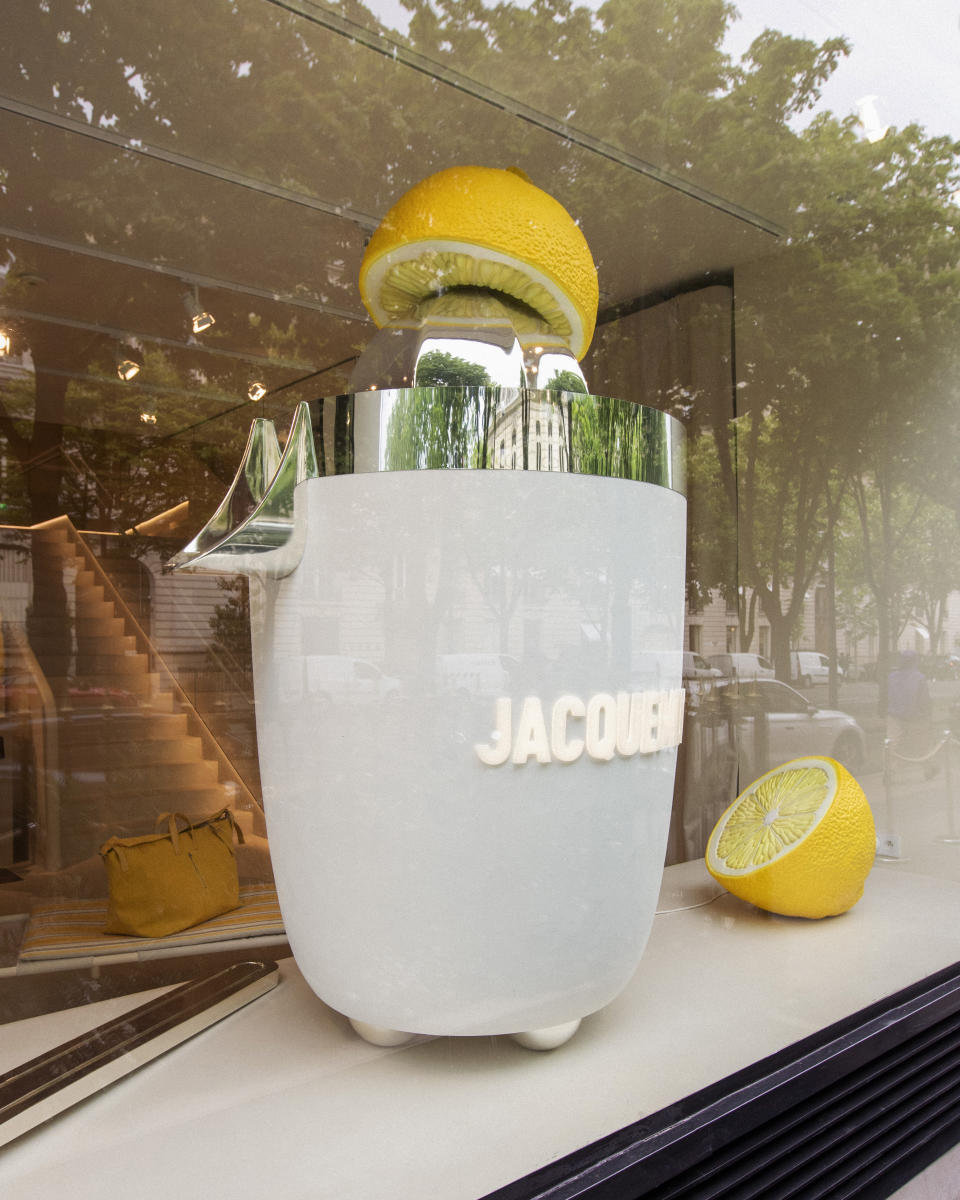What to Watch: Window Dressing in 2023? Clothing Is Strictly Optional
- Oops!Something went wrong.Please try again later.
- Oops!Something went wrong.Please try again later.

“Ultimately, the window is a billboard,” Jonathan Anderson said, explaining why he plunked a giant, very British-looking teapot in the window of his new JW Anderson boutique in Milan instead of a dress. “It’s about storytelling: How do you draw people into a store?”
RELATED: What to Watch: Rei Kawakubo Strips Down Window Dressing
More from WWD
“A window display is a first insight into the brand image, but it still has to attract people and catch their attention,” agreed Simon Porte Jacquemus, who recently installed a cherry-topped cup of whipped cream the size of a Fiat 500 in the window of his Avenue Montaigne store in Paris. It winks to his Marie Antoinette-tinged fall collection that was paraded at the Chateau de Versailles last June.
The two designers are among the ringleaders of a new style of window dressing where clothing is strictly optional, but creativity, bombast and surprise are a must.
“The product is not enough — to retain your customers, you need to entertain them,” said Julien Steenman, who teaches visual merchandising at the Institut Français de la Mode in Paris. “You bring your customer into your universe in a very big and bold way. You need to be quick and efficient today.
“The window becomes the manifesto of the brand.”
Reliant for more than a decade on e-commerce and wholesale channels, Jacquemus first dipped a toe into physical retail last year and was keen to “test disruptive ideas instead of conventional manners of selling.”
“We have always been playing with everyday objects and memories in each of our shows, campaigns and collections so it made sense to us to revisit them in a very absurd and gigantic way,” the designer said, referring to the giant popcorn machine and toaster that have dominated the window “to attract the customers and bring an experience-oriented dimension.
“It’s important for us to create interactions and to provide memories and emotion during the visit of the boutique through its objects, sounds and smells,” he explained in an interview. “We usually work with a more organic and instinctive approach. Everything starts usually from an image, a concept and then evolves into a proper window display.”
Echoing other observers, Anderson said the pervasiveness of social media compels brands and designers to conceive ways to “engage the consumer in a physical way” — and in a “blunt” way, too.
“I think there has been a resurgence of the store,” he said. “As we become more digital, there’s a more romantic view of the store, which is becoming more and more important as a device to tell the brand story.”
So what have the Milanese made of his outsized teapot in the same blue-and-white stripes as his men’s spring 2024 fashion show set?
“Ultimately, it brings curiosity. And I think this is the most important thing.…It’s a provoking tool. We want to be able to get people to question things, and to be noticed,” he said. “You keep reinforcing the message that you’ve already put out there, and keeping it feeling new all the time.”
In his view, an eye-catching object, in sync with the brand spirit, can help build awareness, stir desirability and, ultimately, fan sales.
Anderson noted that he prefers when stores have two windows flanking the entrance. “Because then it’s really like doing a page layout where you have fashion on one side and inspiration on the other,” he said.
According to Steenman, many of the best practices in modern window display come courtesy of Comme des Garçons, whose “non-conformist” ethos raised eyebrows back in the day.
Ever the fashion maverick, Rei Kawakubo never did something as banal as dressing mannequins for a window display — preferring an unexpected, brain-teasing disruption around the entrance.
To wit: A new 302-page book documents the astonishing array of installations Kawakubo conceived for her shop in Tokyo’s Aoyama district between 1989 and 2023.
In 1998, for example, English artist Steven Pippin installed eight sets of sliding glass doors, blurring the lines of entry and exit — and blurring the details of clothes displayed deep inside the boutique.
Cascades of fringe, strange straw baskets, ghoulish foam figurines, giant candles, papier mache elephants, giant red orbs and a pile of bonbons are among the unusual objects that have been visible from the slanted glass windows of the Aoyama store — when they weren’t blacked out with oversize graph paper or graffiti-like artworks.
According to professors of visual merchandising, windows have evolved into a powerful communication tool rather than one for shifting star products, or underperforming products — and spending is on the rise.
“More and more, the brands use window displays to create a link with all the omnichannel experience,” said Alessandro Diani, a professor of visual merchandising at Iuav University in Venice, noting that windows often dovetail from social media content and advertising campaigns. “The window display becomes a physical extension of the value of the brand.”
For example, lemons often appear on the Jacquemus Instagram account — emblematic of his native Provence — and made a cameo as a giant juicer in his Avenue Montaigne window.

“The windows translate his feelings as the extension of social media tools and vice versa,” Diani said. “Oversize is one of the new trends to give emphasis to the brand identity communications or to explain the obsessions of the designers.”
His prediction: “More and more, window display will be a sum of experience, immersion, information, storytelling, and also obsession and addiction, because these six elements are part of the construction of the messaging on Instagram, for example, or TikTok.”
Steenman cited a watershed moment in 2006 when luxury powerhouse Louis Vuitton installed Olafur Eliasson “Eye See You” lamps in its windows for the holidays in lieu of products, reversing the roles of viewer and viewed.
Kawakubo is widely seen as a pioneering figure with her visual merchandising daring, and unique retail formats like “guerrilla” and “pocket” stores.
Diani gives credit to Henry Gordon Selfridges for using the windows of his namesake London department store to display an airplane as a way to mark the first flight across the English Channel, and using windows to support women during the suffragette movement in the 1930s.
In modern times, Vuitton is perhaps the most impressive brand, leveraging technology, innovation and imagination to push the limits of visual merchandising beyond the window to entire buildings, Diani said, mentioning the giant, inflatable figures of Yayoi Kusama that lorded like King Kong over Vuitton flagship stores to promote its recent collaboration with the reclusive Japanese artist.
“It’s really about doing things that are incredibly eye catching and different,” commented Naomi Braithwaite, an associate professor at the Nottingham School of Art and Design in the U.K. “When so much is available online, and there’s so much product online and on social media, this brings people into retail and stirs emotions.…It’s a talking point, it’s a draw, it’s compelling. Windows are a wonderful vehicle for storytelling and captivating consumers.
“It’s not such a novelty to see a dress in the window, because you may have seen it elsewhere,” she noted.
Braithwaite started her fashion career in the ’90s at Harvey Nichols, a London retailer renowned for clever — and occasionally risqué — windows.
“Windows are evolving, as fashion is so much about experience now, not the physical materiality of the clothes or the shoes…but the sensations around them,” she mused.
IFM’s Steenman noted that traditionally, luxury firms “star-ified” their products, while mass market firms required decorations to zhuzh up mediocre merchandise.
Today, however, similar tactics are seen across the price spectrum, with luxury brands displaying outsized or miniature objects as the latest expression of “retail-tainment,” while fast-fashion players like Zara have taken elements of Phoebe Philo-era Celine for its visual merchandising and store design.
Steenman cautioned that only well-known brands should attempt artistic no-product windows, and urged all brands to create different experiences online and in-person, but that are also “linked and coherent.”
“The window is the first message delivered to your clients — so the message needs to be strong, and the message needs to be coherent with all the rest of the communications of the company.”
He noted that even “no-window concepts” can be coherent, citing Bottega Veneta as an example, since it had exited social media.
Like several other designer brands, Bottega lets its windows function as simply a vista into the store, without embellishment. “So that non-window in a way was completely in line with their global communications,” Steenman said. “Non-animation is also communication…you have a refined product. So you need to have a refined setup.”
Nottingham’s Braithwaite detected a recent surge in student interest in visual merchandising after years of focusing on landing pages, social media and other digital expressions of fashion.
“Post-COVID-19, our students have become much more excited again about the physical retail world and thinking about the captivating environment of retail, from windows through to store design, and very much combining it in an immersive way with digital technology,” she said. “I think [windows are] going to become more theatrical, more spectacular.”
Best of WWD

